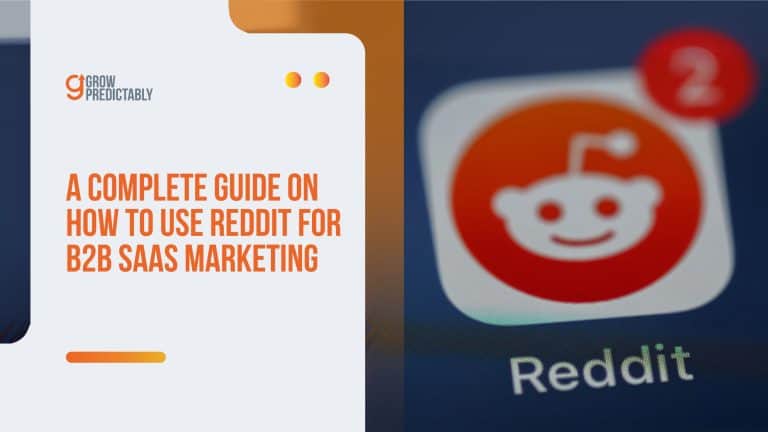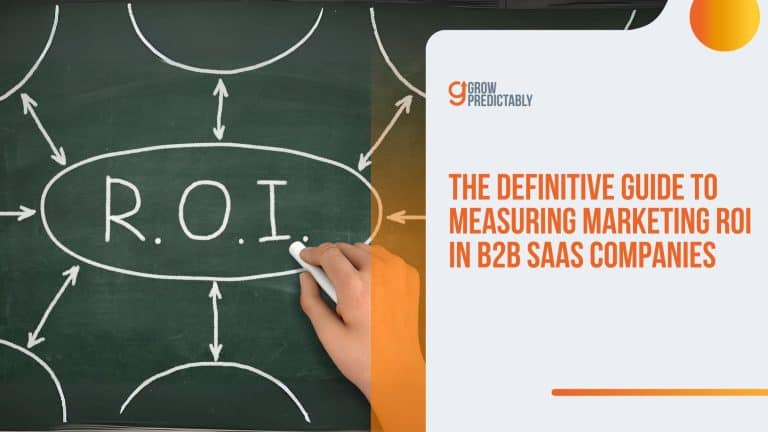NPS for B2B SaaS: Your Ultimate 2025 Guide
Are your B2B SaaS customers disappearing before your eyes?
You’ve built a great product, but they keep leaving.
Frustrating, right?
Here’s the deal: companies with high NPS grow twice as fast as those without it (Bain & Company says so).
NPS for B2B SaaS isn’t just a number; it’s your tool for bigger growth and loyal customers.
Understanding and addressing customer churn is crucial, as losing customers can severely impact your business success and revenue.
We’re laying it all out in the blog.
Want to know how to keep customers happy and turn them into super fans of your brand?
Dive in and discover the secrets.
Ready to shake things up and take your business to the next level?
Let’s make it happen together!
What is Net Promoter Score (NPS)?

NPS is a powerhouse tool for understanding just how much your customers love what you’re offering.
It boils down to one straightforward question: “How likely are you to recommend our company/product/service to a friend or colleague?”
This question might seem simple, but it’s a direct line to your customers’ true feelings about your brand.
The responses you get help you gauge whether you’ve got loyal promoters, passive users, or, less ideally, detractors waiting to jump ship.
Definition and Calculation of NPS
To break it down further, NPS measures customer loyalty by looking at how likely someone is to sing your praises to others.
You score the responses on a scale of 0 to 10, where:
- 9-10: These are your Promoters—they’re loyal enthusiasts who will keep buying and refer others.
- 7-8: These are Passives—they’re satisfied but not overly enthusiastic, which means they could be swayed to a competitor.
- 0-6: These are Detractors—they’re unhappy customers who could damage your brand through negative word-of-mouth.
The NPS is calculated by subtracting the percentage of Detractors from the percentage of Promoters.
This number gives you a score that can help you identify how strong your brand loyalty is.
Importance of NPS in Measuring Customer Satisfaction
The significance of NPS goes beyond just knowing what your customers think.
It’s about harnessing this feedback to fuel growth and perfect your customer experience.
NPS is a crystal-clear indicator of customer satisfaction, loyalty, and overall journey with your product or service.
By regularly tracking NPS, you can spot trends, act on feedback, and ultimately, boost your business’s health and growth trajectory.
NPS in SaaS Companies
In the world of SaaS, NPS isn’t just a nice-to-have—it’s critical.
For SaaS companies, customer success and loyalty are the backbone of sustainable growth.
NPS is invaluable here because it provides a quick snapshot of customer sentiment and helps businesses prioritize initiatives to increase retention and upsell opportunities.
The customer success team is crucial in addressing feedback from NPS surveys, proactively responding to detractors’ concerns, and leveraging promoter feedback to enhance customer relationships.
It can turn your customer base into a solid army of advocates who drive your business forward.
And when your customers are thriving and satisfied, your business is better positioned to scale and succeed.
NPS Benchmarks for SaaS Companies
Understanding Net Promoter Score (NPS) benchmarks is crucial for evaluating where your SaaS company stands in terms of customer loyalty and satisfaction.
Benchmarks provide a reference point, showing how your scores stack up against industry standards.
For SaaS companies, these benchmarks are not just numbers—they’re insights into customer satisfaction and brand health that can guide strategic decisions.
Net Promoter Score Benchmarks for SaaS Companies
According to Survicate’s 2021 NPS benchmarks report, the average NPS score for SaaS companies hovers around 32.
This figure offers a baseline for assessing how well your business performs compared to peers.
It’s a competitive landscape, and knowing where you stand can help you target areas for improvement or celebrate excellence.
Factors Affecting NPS Benchmarks
Several factors play a role in shaping these benchmarks:
- Niche Competition: The intensity of competition within your niche can influence customer expectations and satisfaction levels.
- Customer Tolerance Levels: Different customer segments may have varied tolerance thresholds for service issues or product quirks, affecting their likelihood to recommend.
- Vendor Switching Barriers: If it’s easy or hard for customers to switch vendors, this can significantly impact their loyalty and your NPS score.
By understanding these factors, you can better tailor your strategies to improve your standing and fit the unique traits of your market.
Average NPS Score for SaaS: What to Expect
When it comes to evaluating your NPS score, understanding what constitutes a good NPS score is key.
While the average is around 32, a good NPS score for SaaS companies is typically above 0, with scores between 30 to 70 deemed great and anything above 70 indicating excellent customer satisfaction.
Here’s how to interpret your scores:
- Above 20: This score is considered great, indicating generally positive customer experiences and loyalty.
- Above 50: Achieving this level is amazing and suggests that your customers are not only satisfied but are actively promoting your business to others.
Achieving or exceeding these benchmarks is crucial because it reflects a healthy, thriving customer base, essential for long-term growth and success in the SaaS industry.
Running an NPS Survey

Running an NPS survey might seem daunting, but it’s an essential strategy for collecting valuable insights into customer satisfaction and loyalty.
Whether you’re opting for an in-app survey or an email-based approach, choosing the right method can make all the difference in your response rates and the quality of feedback received.
How to Run an In-App NPS Survey
Using in-app surveys allows you to collect NPS feedback within your product, which can offer instant insights when users actively engage with your service.
Implementing a pop-up or slide-out as part of your survey mechanics leverages users’ real-time interaction with your platform.
Ensure the survey naturally integrates with your brand’s aesthetic for a seamless user experience.
It’s crucial that the survey feels contextual—triggering it appropriately can lead to more honest and frequent responses.
- Choose a non-intrusive design
- Maintain your brand’s color scheme and language
- Contextualize the survey within the user’s journey to maximize relevance
How to Run an NPS Survey Using Email
Email surveys are another powerful way to gather NPS data.
While they might have lower response rates compared to in-app methods, they can reach users who aren’t using your app at the moment, ensuring you gain insights from a broader audience.
You can choose to embed the survey directly within the email or provide a link to a survey page.
This method allows users to respond at their convenience, which can sometimes lead to more thoughtful feedback.
- Keep the email concise and friendly
- Offer a direct link to the survey for easy access
- Consider timing your email to catch recipients at an optimal moment
Best Practices for Survey Distribution and Timing
Timing and distribution play vital roles in the success of your NPS surveys.
To avoid survey fatigue, trigger surveys after specific user interactions, such as after a feature update or customer support interaction.
Monitoring how often users perform certain actions can help determine the ideal times to request feedback without overwhelming them.
- Trigger surveys post-interaction (e.g., after support chats or new feature usage)
- Be mindful of not bombarding users with repetitive survey requests
- Analyze user patterns to tailor survey timing intelligently
Running an effective NPS survey requires a balanced mix of the right tools, strategic timing, and an understanding of user behaviors.
By optimizing how you collect feedback, you can unlock deeper insights into customer sentiments and drive your business forward with informed strategies.
Analyzing NPS Data
Once you’ve gathered your NPS survey results, the next crucial step is analyzing the data to extract meaningful insights.
By segmenting your customer base, cross-referencing data, and diving into open-ended responses, you can understand your customer’s perspectives and sharpen your strategies accordingly.
Segmenting Your Customer Base by NPS Scores
Segmentation is your starting point for a deeper dive into customer feedback.
By categorizing your respondents into Promoters, Passives, and Detractors, you can start to understand the varied reasons behind customer satisfaction or dissatisfaction.
This segmentation allows you to tailor your approach to addressing concerns and leveraging strengths.
- Promoters: Understand what’s working well and what drives their advocacy.
- Passives: Identify what could transform their experience into a promotive one.
- Detractors: Investigate the root causes of their dissatisfaction and strategize improvements.
Cross-Referencing NPS Data with Product Usage Analytics
To gain a multifaceted view of customer behaviors, it’s helpful to blend NPS data with product usage analytics.
This combination can shine a light on patterns related to product features, identifying usage trends that correlate with positive or negative feedback.
For instance, low NPS scores linked to limited feature use could signal usability issues or feature unawareness.
- Evaluate which features align with higher NPS scores
- Identify underutilized features that might need better promotion or redesign
- Analyze frequency and duration of usage for insights into user engagement
Analyzing Open-Ended NPS Responses for Actionable Insights
The richness of open-ended responses lies in their detailed feedback that isn’t captured by a score.
By categorizing and analyzing these qualitative inputs, you can unearth recurring themes that provide a clearer picture of user satisfaction and dissatisfaction.
This deeper dive can lead to actionable insights that drive product improvement and customer success strategies.
- Categorize feedback into common themes or issues
- Look for patterns that align with score trends
- Identify new opportunities for product development or support enhancements
In summary, you uncover the stories behind the numbers by dissecting your NPS data through segmentation, analytics cross-referencing, and detailed response analysis.
This holistic view lets you make data-driven decisions that strengthen customer relationships and foster business growth.
Calculating NPS
Ever wondered how companies like Zoom transform customer feedback into a single, powerful metric?
Let’s break down the Net Promoter Score (NPS) formula—it’s actually simpler than you might think!
This powerful calculation lets you gauge how your customers feel about your service at a glance, helping you turn feedback into action.
NPS boils down all the feedback into one straightforward calculation:
NPS = % of Promoters – % of Detractors
Here’s how customer responses get categorized:
- Promoters (9-10): These are your biggest fans who spread the word and bring in more customers.
- Passives (7-8): They’re satisfied but not ecstatic—meaning they could be won over by competitors.
- Detractors (0-6): Unhappy customers who might advise others to steer clear.
Let’s walk through a real example to see how this works: Imagine you survey 100 customers and receive these scores:
- 60 give scores of 9-10 (Promoters)
- 20 give scores of 7-8 (Passives)
- 20 give scores of 0-6 (Detractors)
Here’s the calculation in action:
60% Promoters – 20% Detractors = +40 NPS
| Response Group | Score Range | Count | Percentage | Impact on NPS |
| Promoters | 9-10 | 60 | 60% | +60 |
| Passives | 7-8 | 20 | 20% | 0 |
| Detractors | 0-6 | 20 | 20% | -20 |
| Final NPS | +40 |
Ready to dive into tracking your NPS? Consider using these tools:
- CustomerGauge: Perfect for B2B companies needing deep analytics.
- Blitzllama: Great for quick, in-product surveys.
- Delighted: Offers user-friendly features and beautiful dashboards.
Now that you’ve got the hang of calculating NPS, remember—getting the number is just the start.
The real magic happens with what you do next.
We’ll explore how to turn these insights into growth strategies in the upcoming sections.
Interpreting NPS Scores
What separates good NPS scores from truly remarkable ones in B2B SaaS?
Let’s decode these numbers to unlock growth insights you can use immediately!
NPS scores aren’t just numbers; think of them as a health check for your customer relationships.
In the world of B2B SaaS, each score reveals something about the status of your customer satisfaction.
NPS Score Interpretation
Tracking different scores gives you critical insights into what constitutes a good net promoter score and its implications for customer experience and satisfaction:
- 🔴 Below 0: You have more unhappy customers than happy ones. This is a red alert—time for deep customer feedback analysis and rapid changes.
- 🟡 0 to +30: You’re on the right track, but there’s plenty of room to grow. Many B2B SaaS companies find themselves here before implementing solid customer success strategies.
- 🟢 +30 to +50: Now we’re talking! This range shows strong customer satisfaction. It’s where successful B2B SaaS companies often thrive.
- ⭐ Above +50: Welcome to the excellence club! These scores are linked to high retention rates and passionate customer advocates.
NPS Scores Across Industries
Comparing NPS scores across industries can offer valuable context:
| Industry | Typical NPS Range | What It Means | |—————–|——————-|————————————–| | B2B SaaS | +30 to +50 | Strong performance level | | Consumer Tech | +50 to +70 | Higher emotional connection | | Healthcare | +20 to +40 | Complex relationship dynamics |
Tracking NPS Scores
Use the Growth Scorecard’s Red-Yellow-Green system to track your NPS weekly and stay ahead:
Red: Score drops 10+ points below your average.
Yellow: Score remains flat for 3+ weeks.
Green: Score trends upward for 2+ weeks.
It’s fascinating but true—NPS scores often predict growth patterns 6-12 months before they manifest in revenue numbers.
Regular tracking is crucial as it becomes your crystal ball for business health.
Connecting NPS and CLV
Want these numbers to pack an even stronger punch?
Connect your NPS with customer lifetime value (CLV).
When companies link these metrics, they often find that Promoters spend 20-30% more over time than Passives.
The Importance of NPS
Remember, your NPS journey isn’t just about hitting a number—it’s about building relationships that drive growth. In our next section, we’ll explore proven strategies to boost these scores.
But first, let’s understand the actions different scores demand:
| Score | Action Needed |
| Below 0 | Emergency response team activation |
| 0-30 | Enhanced onboarding and support focus |
| 30-50 | Referral program optimization |
| 50+ | Case study and advocacy program launch |
Every industry giant started somewhere. Companies with sky-high scores now began with modest numbers, growing through consistent attention to customer feedback. We’ll uncover how to improve your scores in the next section. But for now, start tracking. Remember, what gets measured gets managed—and in B2B SaaS, NPS is one metric you can’t afford to ignore.
5 Strategies for Improving NPS for B2B SaaS
Boosting your Net Promoter Score (NPS) involves a strategic approach that enhances customer satisfaction and loyalty.
By committing to improving customer experiences through targeted strategies, businesses can achieve a higher NPS and deepen their connection with clients.
1. Prioritize Exceptional Customer Service
Exceptional customer service is the cornerstone of a positive customer experience and can significantly influence how customers perceive your brand.
To create a lasting impression, empowering your customer support teams to deliver top-notch service at every interaction is crucial.
Foster an organizational culture that prioritizes customer satisfaction and makes every customer feel valued and heard.
- Empower Support Teams: Provide comprehensive training and resources to ensure support teams can resolve issues efficiently and empathetically.
- Foster a Customer-Centric Culture: Encourage a company-wide ethos where all employees take ownership of customer satisfaction.
- Solicit Feedback on Service: Regularly gather feedback about customer service interactions and use it to identify areas for improvement.
When customer service becomes a seamless and positive experience, it boosts customer perceptions and encourages loyalty, ultimately enhancing NPS.
2. Act on Feedback Promptly
Prompt action on customer feedback can prevent minor issues from escalating and transform negative experiences into positive ones.
Quick resolution of customer complaints demonstrates a commitment to improvement and shows customers that their input is valued.
Establishing a structured feedback loop helps streamline the process of capturing, distributing, and responding to customer feedback across teams.
- Quick Resolution: Develop processes to address complaints swiftly, aiming to resolve issues before they escalate.
- Feedback Loops: Implement systems for capturing feedback, distributing it to relevant departments, and ensuring timely follow-ups.
- Transparency: Communicate back to customers about the actions taken based on their feedback, reinforcing their role in your continuous improvement.
With an effective feedback system in place, customers see tangible results from their input, fostering trust and encouraging continued engagement.
3. Enhance Product or Service Offerings
Improving your offerings to better align with customer expectations can significantly elevate customer satisfaction.
Use insights from customer feedback to inform product development and ensure that new features and updates meet the evolving needs of your clientele.
Continuously innovating while addressing prevalent customer concerns helps maintain a competitive edge and satisfies customer demand.
- Ongoing Development: Regularly update products or services based on direct customer feedback to meet changing needs.
- Innovations and Updates: Introduce new features or improvements that solve customer problems and add value.
- Market Trends: Stay informed about industry trends to anticipate customer needs and remain at the forefront of innovation.
By consistently enhancing your product or service offerings, you keep customers engaged and satisfied, driving loyalty and boosting your NPS.
4. Create Rewarding Customer Experiences
Creating experiences that exceed customer expectations is vital for nurturing loyalty and promoting positive word-of-mouth.
Personalization is key; tailor interactions and offers to make each customer feel valued.
Implementing loyalty programs can provide additional incentives for customers to remain committed to your brand.
- Personalization: Customize communications and offers to cater to individual customer preferences and needs.
- Loyalty Programs: Design programs that offer rewards or benefits for repeat purchases and referrals, strengthening customer ties.
- Memorable Interactions: Strive to create memorable experiences at every touchpoint, leaving customers with a lasting positive impression.
When you create rewarding and personalized experiences, customers are more likely to become promoters of your brand, ultimately enhancing your NPS.
5. Engage Customers as Partners
Treating customers as partners in your business journey leads to deeper engagement and a sense of shared success.
Regularly engage with customers to gather insights, showing that their opinions are not only heard but valued.
Involving them in the development process or testing phases provides them with a stake in the offerings they use and promotes loyalty.
- Regular Check-Ins: Schedule regular interactions through surveys or calls to gather continual feedback and insights.
- Promoter Engagement: Involve loyal customers in beta testing or forums where they can directly influence upcoming releases.
- Collaborative Development: Encourage customers to contribute ideas and suggestions, fostering a sense of partnership and shared growth.
By engaging customers as collaborative partners, you strengthen relationships, enhance satisfaction, and create a community of advocates, all contributing to a higher NPS.
NPS and Customer Feedback
Net Promoter Score (NPS) surveys are a powerful tool for gathering and analyzing customer feedback, providing valuable insights into customer satisfaction and loyalty.
By strategically implementing NPS surveys, you can turn feedback into actionable strategies to foster stronger customer relationships.
Using NPS to Collect and Analyze Customer Feedback
NPS surveys do more than just provide a score—they offer a window into customer experiences that can help shape strategic decisions. Measuring overall customer satisfaction through NPS surveys is crucial for understanding client perspectives and enhancing service delivery.
Collecting NPS data allows you to uncover patterns and areas for improvement, enabling targeted actions to enhance the overall customer experience.
- Actionable Insights: NPS identifies key drivers of customer loyalty, enabling tailored approaches to boost satisfaction.
- Customer Segmentation: Use NPS to segment customers into Promoters, Passives, and Detractors, offering insights into different customer needs and preferences.
- Feedback Trends: Analyze recurring themes and trends in customer feedback to proactively address emerging issues.
Tips for Increasing Response Rates in NPS Surveys
High response rates are crucial for obtaining accurate and reliable insights from NPS surveys.
Implementing targeted strategies can enhance participation and the quality of feedback received.
- Survey Design: Keep surveys concise and focused. Tailor questions to resonate with your audience and ensure they’re easy to understand.
- Timing and Relevance: Send surveys at moments when customers are most engaged, such as after a purchase or service interaction.
- Incentives: Offer incentives, like discounts or entry into a prize draw, to encourage participation without biasing responses.
- Multichannel Distribution: Use a mix of email, in-app, and phone surveys to reach customers on their preferred platforms.
- Personalization: Personalize survey communications to make customers feel valued and more likely to engage.
- Follow-Up: Show appreciation for feedback and inform respondents of any actions taken as a result, reinforcing the value of their input.
Your B2B SaaS company can unlock deeper insights into its customer base by effectively leveraging NPS and focusing on enhancing response rates.
This leads to informed strategies that not only address current challenges but also strengthen customer loyalty and satisfaction over the long haul.
NPS Implementation and Best Practices
Implementing an NPS program effectively in a B2B context involves clear objectives, timing, and actionable insights.
A thoughtful approach ensures the collection of meaningful feedback and drives improvements in customer satisfaction and loyalty.
Identifying the Objective of Your NPS Program
Establishing clear objectives for your NPS program is the first step toward successful implementation.
Understanding what you hope to achieve will focus your efforts and ensure you gather the most relevant feedback.
- Clarify Goals: Decide whether your priority is improving customer satisfaction, reducing churn, increasing referrals, or a combination of these factors.
- Target Audience: Identify which segments of your customer base you wish to focus on for insights—long-term clients, new clients, or specific product users.
- Performance Metrics: Define success metrics to gauge the effectiveness of your NPS program, such as a specific score increase or reduction in customer support tickets.
Launching Surveys at the Right Touchpoint and Asking the Right Questions
Timing and context are essential for gathering genuine feedback via NPS surveys.
Selecting strategic touchpoints ensures high engagement rates and relevant responses.
- Optimal Timing: Schedule surveys post-interaction, such as after a purchase, product trial, or customer service interaction, when experiences are fresh.
- Targeted Questions: Craft questions that align with the touchpoint—questions should be concise, direct, and relate to the specific customer experience.
- Survey Integration: Incorporate NPS surveys seamlessly into customer interactions, whether in-app, via email, or during routine communications, to minimize disruption.
Analyzing Received Data and Taking Action
The real power of NPS lies in analyzing the data collected and transforming insights into actionable strategies that improve customer experience.
- Data Analysis: Look for patterns in feedback across Promoters, Passives, and Detractors to identify strengths and weaknesses.
- Follow-Up Actions: Develop specific action plans to address feedback, whether through product improvements, service enhancements, or policy changes.
- Continuous Improvement: Use insights to implement continuous improvements and communicate changes to customers to show that their feedback is valued.
By clearly identifying objectives, timing the deployment of surveys correctly, and turning insights into action, B2B companies can maximize the benefits of their NPS programs.
This not only enhances customer satisfaction and loyalty but also builds a proactive culture of continuous improvement.
Monetizing Your NPS Program
Unlocking the monetary potential of your NPS program can propel business growth and enhance customer retention.
NPS scores provide a clear window into customer loyalty and satisfaction, serving as crucial indicators for business performance and growth opportunities.
- Linking NPS to Financial Outcomes: By connecting NPS insights to business metrics, such as churn rates and customer lifetime value (CLV), you gain clarity on how customer satisfaction impacts profits.
- Retention Strategies: Use NPS feedback to identify areas of improvement that can reduce churn. Addressing Detractor concerns can convert them into loyal customers who contribute to steady revenue streams.
- Growth Measurement: Regularly track NPS alongside key performance indicators to monitor how improvements influenced by feedback correlate with growth metrics.
A well-monetized NPS program not only supports current growth but also builds a resilient framework for long-term business success.
NPS Tools and Software
The right NPS tools are crucial for effectively gathering and analyzing customer feedback.
The right software provides insights, scales with your business needs, and integrates smoothly into your existing systems.
Focusing on key features and best practices enables you to make an informed decision that enhances your customer feedback strategy.
What to Look for in NPS Tools
When evaluating NPS tools, it’s essential to focus on features that support your business objectives and provide valuable insights.
- Customization: Look for tools that offer flexibility in survey design and delivery. Customization options allow you to tailor questions and branding, ensuring the survey aligns with your company image and elicits relevant feedback.
- Scalability: Choose a tool that can grow with your business. As your customer base expands, your NPS software should handle increased data collection and analysis without a hitch.
- Analytics: Robust analytics capabilities are essential. The ability to easily segment data, identify trends, and produce insightful reports helps you turn raw data into actionable strategies.
Best Practices for Selecting and Implementing NPS Software
Choosing and implementing the right NPS tool involves understanding your specific needs and evaluating options that best meet them.
- Identify Needs: Start by clearly defining what you need from an NPS tool—is it advanced analytics, ease of use, integration capabilities with other systems, or all of the above? Understanding your priorities helps narrow down options.
- Explore Options: Consider popular tools like Wootric or Satismeter, which are known for their user-friendly interfaces and comprehensive analytics. Evaluate how each tool aligns with your specific requirements.
- Integration: Ensure the tool integrates seamlessly with your existing CRM and analytics platforms. This facilitates smoother data flow and more comprehensive insights.
- Testing: Before full implementation, test the software with a segment of your customer base to evaluate its effectiveness and suitability.
- Training and Support: Prioritize tools that offer strong customer support and training resources to ensure your team can effectively utilize the software.
By focusing on customization, scalability, and analytics and aligning your choice with business needs, you can select and implement an NPS tool that maximizes the value of customer feedback and supports your growth objectives.
Common NPS Mistakes to Avoid
Implementing a successful NPS program requires careful planning and execution. It’s easy to fall into common pitfalls that can skew results or diminish their effectiveness.
Avoiding these pitfalls is crucial for maintaining the integrity and usefulness of your NPS data.
- Survey Fatigue: Regularly bombarding users with surveys can lead to fatigue, reducing response rates and the quality of feedback. Instead, strategically time surveys after significant interactions or changes to keep feedback fresh and relevant.
- Poor Survey Design: Without thoughtful framing, questions can lead to misleading results. Ensure questions are clear, concise, and directly tied to aspects of the customer experience you wish to improve.
- Lack of Segmentation: Treating all customers as a homogeneous group can obscure crucial insights. Segment your customers by demographics, purchase behavior, or interaction history for more targeted insights.
FAQs
The Competitive Advantage You Can’t Ignore
Here’s the reality: In the hyper-competitive B2B SaaS space, companies that listen to their customers grow faster than those that don’t.
NPS isn’t just another metric—it’s the compass guiding your business to stronger retention, lower churn, and higher customer lifetime value.
When companies like Zoom and Nutanix use it to drive their strategy, it’s not by chance—it’s by design.
So, the question isn’t whether you should track NPS—it’s how soon you can start using it effectively.
✔️ Set up weekly NPS reviews with your team.
✔️ Categorize scores into Red-Yellow-Green to identify risks/opportunities.
✔️ Take swift action when issues arise—delays cost growth.
If you want to explore industry benchmarks and best practices, download our in-depth “B2B SaaS NPS Benchmark Report” today.
What will your company’s NPS look like in six months?
That depends on what you do next.
Let’s make it count.








